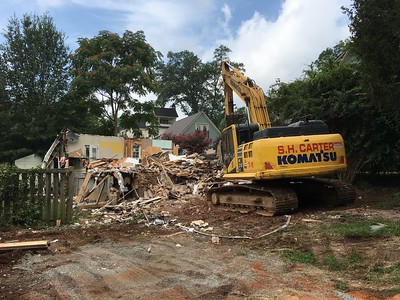Yesterday, I wrote about the home-price-to-income ratio, and how the calculation identifies areas where people struggle to afford housing. The calculation is simple: divide the median home price by the area’s median household income. The higher the number, the more difficult it is to afford a home there.
There are a few ways to wag the dog in this particular calculation. Flooding the area with higher income earners (gentrification) can lower the ratio, but that may come at the cost of displacing people who already live there. If the available housing stock is of comparatively low quality, that tends to attract short-term investor-owners, who buy distressed homes and upgrade them to resell them at significant profit.
Building more homes could alleviate the demand for them if prices are high due to scarcity. If the market rate for homes is high enough, it may make sense to some buyers to build on vacant land, or even raze an existing home to make way for new construction.
Cities – especially those that have already been fully developed – have little opportunity to permit new residential construction because there is little in the way of undeveloped land. Deed restrictions, zoning requirements, poor infrastructure, land contamination, and other similar complications may prevent additional residential construction in a city even when the demand for homes there is high.
Ypsilanti has a profound lack of buildable land right now. The city has been nearly fully developed, so new residential construction requires clearing existing parcels. Without annexing land from the surrounding townships (which is not likely to happen), there won’t be many new housing starts in Ypsilanti anytime soon.
Limited housing options invite gentrification
The other addressable factor – median household income – either requires a comprehensive plan to enable existing residents to increase their earnings – or it requires a large-scale influx of high-earning households to replace the existing residents. I don’t think gentrification has a lot of community support, but with persistent demand for housing in the area and lack of available homes, gentrification is likely to happen, regardless of whether people want it or not.
The thing to remember is this: the displacement of current residents isn’t limited to Ypsilanti. The home-price-to-income ratio shows that the unaffordability of housing in Ypsilanti is profound based on the median income of the area. But areas in Ann Arbor are facing the same challenges, particularly in the 48103 and 48104 ZIP codes. Chelsea also faces a housing affordability problem. Residents in those areas are just as likely to be displaced by higher-earning homebuyers who can better manage the cost of living in those areas.
If we are going to preserve the ability for existing Washtenaw County residents to remain here, we need mechanisms to strike a better balance between the cost of living here and the income of existing residents. Part of the solution is to build more homes that appeal to buyers in all price ranges. Another piece of the puzzle is to improve economic development opportunities for new employers and new industries. A third piece is to create educational programs that prepare existing residents to fill the high-wage, high-demand jobs that the county attracts. This is why we send nearly $80M to Washtenaw Community College, and we’re going to need to start seeing a return on that investment.
Photo Credit: Greenville Daily Photo , via Flickr



























